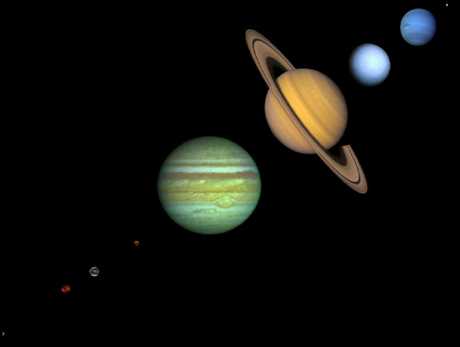 Galileo: the Telescope &
Galileo: the Telescope &
the Laws of Dynamics
 Galileo Galilei (1564-1642) was a pivotal figure in the development of modern
astronomy, both because of his contributions directly
to astronomy, and because of his
work in physics and its relation to astronomy. He provided the crucial
observations that proved the Copernican hypothesis, and also laid the
foundations for a correct understanding of how objects moved on the surface of
the earth (dynamics) and of gravity.
Galileo Galilei (1564-1642) was a pivotal figure in the development of modern
astronomy, both because of his contributions directly
to astronomy, and because of his
work in physics and its relation to astronomy. He provided the crucial
observations that proved the Copernican hypothesis, and also laid the
foundations for a correct understanding of how objects moved on the surface of
the earth (dynamics) and of gravity.
Newton, who was born the same year that Galileo died,
would build on Galileo's ideas to demonstrate that the laws of motion in the
heavens and the laws of motion on the earth were one and the same. Thus,
Galileo began and Newton completed a synthesis of astronomy and physics
in which the former was recognized as
but a particular example of the latter, and
that would banish the notions of Aristotle almost completely from both.
One could, with considerable justification, view Galileo as the father both of
modern astronomy and of modern physics.
The Telescope
Galileo did not invent the telescope
(Dutch spectacle makers receive that
credit), but he was the first to use the telescope to study
the heavens
systematically. His
little telescope
was poorer than even a cheap
modern amateur telescope, but what he observed in the heavens rocked the very
foundations of Aristotle's universe and the theological-philosophical worldview
that it supported. It is said that what Galileo saw was so
disturbing for some officials of the Church that they refused to even
look through
his telescope; they reasoned that the Devil was capable of making
anything appear in the telescope, so
it was best not to look through it.
Sunspots
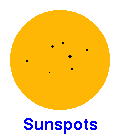 Galileo observed the Sun through his telescope and saw that the
Sun had
dark patches on it that we now call
sunspots (he eventually
went blind, perhaps from damage suffered by looking at the Sun with his
telescope). Furthermore, he observed motion of the sunspots indicating that
the Sun was rotating on an axis. These "blemishes" on the Sun were contrary to
the doctrine of an unchanging perfect
substance in the heavens, and the rotation of the
Sun made it less strange that the Earth might rotate on an axis too, as
required in the Copernican model. Both represented new facts that were unknown
to Aristotle and Ptolemy.
Galileo observed the Sun through his telescope and saw that the
Sun had
dark patches on it that we now call
sunspots (he eventually
went blind, perhaps from damage suffered by looking at the Sun with his
telescope). Furthermore, he observed motion of the sunspots indicating that
the Sun was rotating on an axis. These "blemishes" on the Sun were contrary to
the doctrine of an unchanging perfect
substance in the heavens, and the rotation of the
Sun made it less strange that the Earth might rotate on an axis too, as
required in the Copernican model. Both represented new facts that were unknown
to Aristotle and Ptolemy.
The Moons of Jupiter
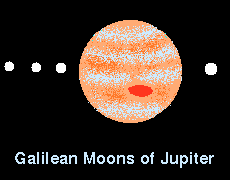 Galileo observed 4 points of light that changed their
positions with time
around the planet Jupiter. He concluded that these were objects in
orbit around Jupiter. Indeed, they were the 4 brightest moons of Jupiter,
which are now
commonly called the Galilean moons (Galileo himself called them
the Medicea Siderea---the ``Medician Stars''). Here is an
animation
based on actual observations of the motion of these moons around Jupiter.
Galileo observed 4 points of light that changed their
positions with time
around the planet Jupiter. He concluded that these were objects in
orbit around Jupiter. Indeed, they were the 4 brightest moons of Jupiter,
which are now
commonly called the Galilean moons (Galileo himself called them
the Medicea Siderea---the ``Medician Stars''). Here is an
animation
based on actual observations of the motion of these moons around Jupiter.
These
observations again showed that there were new things in the heavens that
Aristotle and Ptolemy had known nothing about. Furthermore, they demonstrated
that a planet could have moons circling it that would not be left behind as the
planet moved around its orbit. One of the arguments against the
Copernican
system (and the ORIGINAL heliocentric idea of Aristarchus)
had been that if the moon were in orbit around the Earth and the Earth
in orbit around the Sun, the Earth would leave the Moon behind as it moved
around its orbit.
The Phases of Venus
Galileo used his telescope to show that Venus went
through a complete set of
phases, just like the Moon. This observation was
among the most important in human history, for it provided the first conclusive
observational proof that was consistent with the
Copernican system but not the Ptolemaic system.
The crucial point is the empirical fact that Venus
is never very far from the Sun in our sky.
Thus, as the following diagrams
indicate, in the Ptolemaic system Venus should always be in crescent phase as
viewed from the Earth because as it moves around its epicycle it can never be
far from the direction of the sun (which lies beyond it),
but in the Copernican system Venus should exhibit a
complete set of phases over time as viewed from the Earth because it is
illuminated from the center of its orbit.
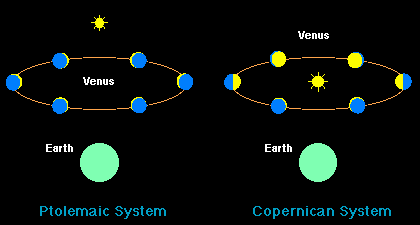 |
|
Phases of Venus in the Ptolemaic and Copernican systems
|
It is important to note that this was the first empirical
evidence (coming almost a century after Copernicus) that allowed a
definitive test of the two models. Until that point, both
the Ptolemaic and Copernican models described the
available data. The primary attraction of the Copernican system was that it
described the data in a simpler fashion, but here finally was
conclusive evidence that not only was the Ptolemaic universe more complicated,
it also was incorrect.
Myriad Observations Showing Phenomena Unknown to Aristotle
In addition to the observations noted above, Galileo made many other
observations that undermined the authority on which the Ptolemaic universe was
built. Some of these included
- Showing that the planets were disks, not points of light, as seen through
the telescope.
- Showing that the great "cloud" called the Milky Way (which we now know to
be the disk of our spiral galaxy) was composed of enormous numbers of stars
that had not been seen before.
- Observing that the planet Saturn had "ears". We now know that Galileo was
observing the rings of Saturn, but his telescope was not good enough to show
them as more than extensions on either side of the planet.
- Showing that the Moon was not smooth, as had been assumed, but was covered
by mountains and craters.
As each new wonder was observed, increasing doubt was cast on the prevailing
notion that there was nothing new to be observed in the heavens because they
were made from a perfect, unchanging substance. It also raised the
credibility issue:
could the authority of
Aristotle and Ptolemy be trusted concerning the nature of the
Universe if there were so many things in the Universe about which they had been
completely unaware?
Galileo and the Leaning Tower
Galileo made extensive contributions to our understanding of the laws governing
the motion of objects. The famous Leaning Tower of Pisa experiment may be
apocryphal. It is likely that Galileo himself did not drop two objects of very
different weight from the tower to prove that (contrary to popular
expectations) they would hit the ground at the
same time. However, it is certain that Galileo understood the principle
involved, and probably did similar experiments. The realization that, as we
would say in modern terms, the acceleration due to gravity is independent of
the weight of an object was important to the formulation
of a theory of gravitation by
Newton. Here is an
animation of experiments with inclined planes
that Galileo probably did
to confirm these ideas.
Galileo and the Concept of Inertia
Perhaps Galileo's greatest
contribution to physics was his formulation of the concept of inertia:
an object in a state of motion possesses an ``inertia'' that
causes it to remain in that state of motion unless an
external force acts on it. In order to arrive at this conclusion, which will
form the cornerstone of
Newton's laws of motion (indeed, it will become
Newton's First Law of Motion), Galileo had to abstract from what he, and
everyone else, saw.
Most objects in
a state of motion do NOT remain in that state of motion. For example, a block
of wood pushed at constant speed across a table quickly comes to rest when we
stop pushing. Thus, Aristotle held that
objects at rest remained at rest
unless a force acted on them, but that objects in motion did not remain in
motion unless a force acted constantly on them. Galileo, by virtue of a
series of experiments (many with objects sliding down inclined planes),
realized that the analysis of Aristotle was incorrect because it failed to
account properly
for a hidden force: the frictional force between the surface
and the object.
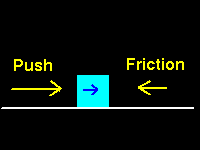 Thus, as we push the block of wood across the table, there are
two opposing forces that act: the force associated with the push,
and a force that is
associated with the friction and that acts in the opposite direction.
Galileo realized that as the frictional forces were decreased (for
example, by placing oil on the table) the object would move further and further
before stopping. From this he abstracted a basic form of
the law of inertia: if the
frictional forces could be reduced to exactly zero (not possible in a realistic
experiment, but it can be approximated to high precision)
an object pushed at constant speed
across a frictionless surface of infinite extent will continue at that speed
forever after we stop pushing, unless a new force acts on it at a later time.
Thus, as we push the block of wood across the table, there are
two opposing forces that act: the force associated with the push,
and a force that is
associated with the friction and that acts in the opposite direction.
Galileo realized that as the frictional forces were decreased (for
example, by placing oil on the table) the object would move further and further
before stopping. From this he abstracted a basic form of
the law of inertia: if the
frictional forces could be reduced to exactly zero (not possible in a realistic
experiment, but it can be approximated to high precision)
an object pushed at constant speed
across a frictionless surface of infinite extent will continue at that speed
forever after we stop pushing, unless a new force acts on it at a later time.
Galileo and the Church
Galileo's challenge of the Church's authority through his assault on the
Aristotelian conception of the Universe eventually got him into deep trouble
with the
Inquisition. Late in his life he was
forced to recant publicly his Copernican views
and spent his last years essentially under house arrest.
His story certainly constitutes one of the sadder examples of the conflict
between the scientific method and "science" based on unquestioned
authority. Unfortunately, there still are many forces in modern society that
would shackle the scientific method of open enquiry in idealogical
chains of one kind or another.
Amusingly,
In 1992, John Paul proclaimed that the Vatican had erred when it condemned
Galileo about 400 years earlier--this investigation started in 1979.
Supplementary References
 Galileo Galilei (1564-1642) was a pivotal figure in the development of modern
astronomy, both because of his contributions directly
to astronomy, and because of his
work in physics and its relation to astronomy. He provided the crucial
observations that proved the Copernican hypothesis, and also laid the
foundations for a correct understanding of how objects moved on the surface of
the earth (dynamics) and of gravity.
Galileo Galilei (1564-1642) was a pivotal figure in the development of modern
astronomy, both because of his contributions directly
to astronomy, and because of his
work in physics and its relation to astronomy. He provided the crucial
observations that proved the Copernican hypothesis, and also laid the
foundations for a correct understanding of how objects moved on the surface of
the earth (dynamics) and of gravity.
 Galileo: the Telescope &
Galileo: the Telescope &  Galileo observed the Sun through his telescope and saw that the
Sun had
dark patches on it that we now call
sunspots (he eventually
went blind, perhaps from damage suffered by looking at the Sun with his
telescope). Furthermore, he observed motion of the sunspots indicating that
the Sun was rotating on an axis. These "blemishes" on the Sun were contrary to
the doctrine of an unchanging perfect
substance in the heavens, and the rotation of the
Sun made it less strange that the Earth might rotate on an axis too, as
required in the Copernican model. Both represented new facts that were unknown
to Aristotle and Ptolemy.
Galileo observed the Sun through his telescope and saw that the
Sun had
dark patches on it that we now call
sunspots (he eventually
went blind, perhaps from damage suffered by looking at the Sun with his
telescope). Furthermore, he observed motion of the sunspots indicating that
the Sun was rotating on an axis. These "blemishes" on the Sun were contrary to
the doctrine of an unchanging perfect
substance in the heavens, and the rotation of the
Sun made it less strange that the Earth might rotate on an axis too, as
required in the Copernican model. Both represented new facts that were unknown
to Aristotle and Ptolemy.
 Galileo observed 4 points of light that changed their
positions with time
around the planet Jupiter. He concluded that these were objects in
orbit around Jupiter. Indeed, they were the 4 brightest moons of Jupiter,
which are now
commonly called the Galilean moons (Galileo himself called them
the Medicea Siderea---the ``Medician Stars''). Here is an
animation
based on actual observations of the motion of these moons around Jupiter.
Galileo observed 4 points of light that changed their
positions with time
around the planet Jupiter. He concluded that these were objects in
orbit around Jupiter. Indeed, they were the 4 brightest moons of Jupiter,
which are now
commonly called the Galilean moons (Galileo himself called them
the Medicea Siderea---the ``Medician Stars''). Here is an
animation
based on actual observations of the motion of these moons around Jupiter.

 Thus, as we push the block of wood across the table, there are
two opposing forces that act: the force associated with the push,
and a force that is
associated with the friction and that acts in the opposite direction.
Galileo realized that as the frictional forces were decreased (for
example, by placing oil on the table) the object would move further and further
before stopping. From this he abstracted a basic form of
the law of inertia: if the
frictional forces could be reduced to exactly zero (not possible in a realistic
experiment, but it can be approximated to high precision)
an object pushed at constant speed
across a frictionless surface of infinite extent will continue at that speed
forever after we stop pushing, unless a new force acts on it at a later time.
Thus, as we push the block of wood across the table, there are
two opposing forces that act: the force associated with the push,
and a force that is
associated with the friction and that acts in the opposite direction.
Galileo realized that as the frictional forces were decreased (for
example, by placing oil on the table) the object would move further and further
before stopping. From this he abstracted a basic form of
the law of inertia: if the
frictional forces could be reduced to exactly zero (not possible in a realistic
experiment, but it can be approximated to high precision)
an object pushed at constant speed
across a frictionless surface of infinite extent will continue at that speed
forever after we stop pushing, unless a new force acts on it at a later time.